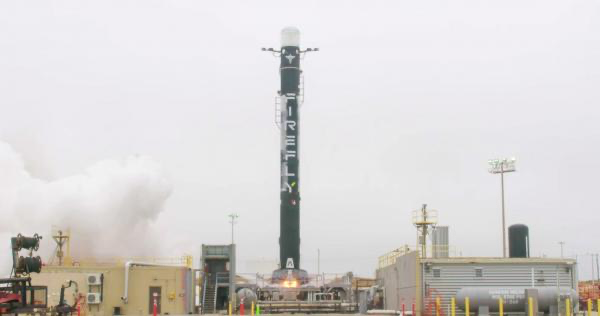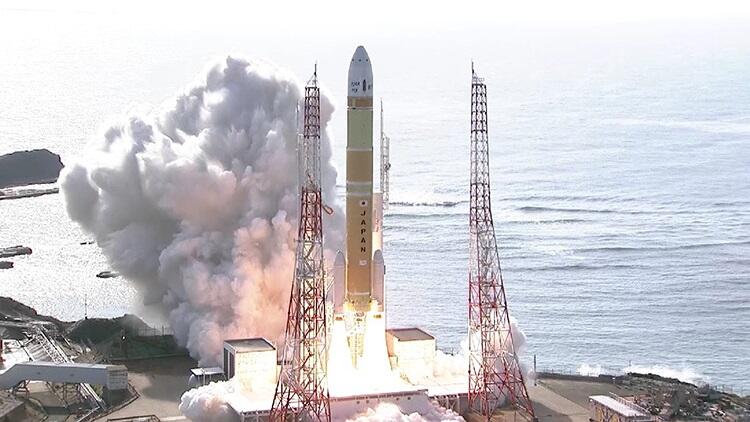After a week in which Tropical Storm Alberto caused high seas, wind and rain-related delays to the Florida launch schedule, SpaceX hopes to get back on track this week with launches planned for the three active Falcon launch pads, including a heavy Falcon.
Towards the end of the week, the Japan Aerospace and Exploration Agency (JAXA) will attempt the third launch of the H3 rocket from JAXA’s Tanegashima Launch Site in Japan. Additionally, Firefly Alpha returns with its first mission of the year from Vandenberg Space Base (VSFB) in California.
Given the reconfiguration of the Falcon Heavy launch pad from Launch Complex 39A (LC-39A) at the Kennedy Space Center, SpaceX was unable to schedule any Falcon 9 launches from this platform since May 24. SpaceX will therefore try to make maximum use of its other east coast platform, Space Launch Complex 40 (SLC-40), at the adjacent Cape Canaveral space station.
However, the bad weather may not be over yet for Florida. With hurricane season underway and more tropical storms brewing, launch schedules will likely be affected. Weather conditions also affect maritime assets as recovery vessels must avoid storms, leading to further disruption and delays.
SpaceX Falcon 9 | Starlink Group 9-2
Launched on Sunday, June 23 at 8:47 p.m. PDT (Monday, June 24 at 3:47 a.m. UTC) from VSFB’s SLC-4E, a SpaceX Falcon 9 lifted the second batch of Group 9 Starlink v2 Mini satellites. Of course I still love you supported the mission and was stationed approximately 600 km downstream. The booster landed on the drone after completing ascent, second stage separation, and a controlled return, using an inlet burn to slow the rate of descent and a landing burn to bring it to a soft landing.
SpaceX Falcon 9 B1075-11 launches Starlink Group 9-2 from SLC-4E, Vandenberg.
Information: https://t.co/O10EzKQ9Rr
Live stream: https://t.co/ryban1KPm2 pic.twitter.com/wc39ivKZWp
– Chris Bergin – NSF (@NASASpaceflight) June 24, 2024
The mission launched on a southeastward trajectory, placing the payload of 20 satellites into a 53-degree inclined orbit. Thirteen of the Starlinks have Direct-to-Cell capability, a pioneering feature that allows a mobile phone to communicate directly with the satellite when no other service exists.
The B1075, the booster for this mission, flew after a lead time of 97 days, with this mission being its 11th flight. Previously, the booster flew Starlink Group 2-4, Transport and Tracking Tranche 01, Starlink Group 2-9, Starlink Group 5-7, Starlink Group 6-20, Starlink Group 7-3, Starlink Group 7-6, SARah 2 and 3, Starlink Group 7-12, Starlink Group 7-16 and USA 350 and 351.
The booster has completed all of its previous missions from Vandenberg, flying for the first time on January 19, 2023. It has already landed twice in Landing Zone 4 and eight times on Of course, I still love you.
SpaceX Heavy Falcon | VA-U
Falcon Heavy proceeds to the launch pad at 39A to @NASAthe GOES-U mission of pic.twitter.com/akvjroyQs3
– SpaceX (@SpaceX) June 25, 2024
The tenth flight of a SpaceX Falcon Heavy rocket is scheduled to take place on Tuesday, June 25 at 5:16 p.m. EDT (9:16 p.m. UTC). Launched from the historic LC-39A at the Kennedy Space Center, Falcon Heavy will elevate the GOES-U weather satellite to a geostationary transfer orbit, flying due east to take full advantage of the Earth’s rotation and achieve additional performance.
With a payload weighing more than 5,000 kg, the Falcon Heavy’s central core, the B1087, will be exhausted, as it is unable to retain enough propellant to soft-land a droneship. The two side boosters, B1072 and B1086, will make a return landing to the launch site in landing zones 1 and 2, respectively. The three boosters fly for the first time.
Ceres 1S | Payload unknown
Chinese company Galactic Energy will launch a four-stage Ceres 1S rocket on Thursday, June 26 at 05:30 UTC. The mission will consist of a sea launch from coastal waters adjacent to the Haiyang spaceport. The mission payload is currently unknown. This will be the fourth launch of Ceres 1 in 2024.
Firefly Alpha FLTA005 | ELaNa 43 “Summer Noise”

Firefly FLTA005 static light. (Credit: Firefly Aerospace)
On Wednesday, June 26 at 9:03 p.m. PDT (Thursday, June 27 at 4:03 a.m. UTC), Firefly Aerospace’s two-stage Alpha rocket will make its first flight of 2024 from SLC-2W at VSFB with an array of cubesats on board. be in orbit.
This mission is part of the Venture-Class Launch Services Demonstration 2 contract between NASA and Firefly. The payload’s eight satellites are mostly cubesats built by universities, while three are built by NASA. Venture-Class is intended to provide greater access to space for colleges and other small-scale businesses. Payloads built by the university are selected through NASA’s CubeSat Launch Initiative (CSLI), intended to support such projects, and each flight is given a collective mission name in the Educational Launch of Nanosatellites (ELaNa) range. ), this flight forming ELaNa 43.
NASA’s Johnson Space Center in Houston flies two R5 satellites, S4 and S2 2.0. These small flying devices are built from off-the-shelf (COTS) components and are intended to test their suitability as low-cost on-orbit inspection devices.
NASA Ames Research Center also has a satellite on board – TechEdSat 11 (TES 11) – the latest and largest iteration of the NASA Ames exo-braking experiment, which uses a similar device to an umbrella to increase a spacecraft’s drag and safely remove it from orbit in a controlled re-entry.
The remaining satellite payloads have small experimental features designed by the students. A new experiment is taking place aboard CatSat, a 6u CubeSat built by the University of Arizona. CatSat will almost achieve a sun-synchronous orbit and use it to stay in constant daylight. Expected to operate for about six months, the cubesat will perform high-resolution Earth imaging, use monitoring of HAM radio signals to measure the ionosphere, and test an inflatable antenna.
This launch livestream will be hosted by Firefly in collaboration with NSF.
The Firefly team prepares for another responsive space demonstration for Alpha #FLTA005 #SummerNoise, NET launch on June 26. Many of our final launch operations begin less than 24 hours after scheduled liftoff. We will share a summary of operations during our… pic.twitter.com/ooufwvaKed
– Firefly Aerospace (@Firefly_Space) June 24, 2024
SpaceX Falcon 9 | Starlink Group 10-3
Another batch of Starlink v2 Mini satellites will be launched into orbit by a SpaceX Falcon 9 booster. The mission will launch from SLC-40 at the Cape Canaveral Space Station on Thursday, June 27 at 7:00 a.m. EDT (11:00 UTC).
Flying northeast, the booster will burn for about 150 seconds before separating from the second stage, which will then fire its single Merlin engine on empty to take the payload into a 53-degree inclined orbit.
The booster will return to land on the autonomous drone ship Just read the instructions stationed approximately 600 km downstream from the platform.
JAXA H3-22S | ALOS-4/Daichi-4
The third launch attempt of the JAXA H3 rocket will take place from the Yoshinobu Launch Complex at the JAXA Space Center in Tanegashima, Japan, on Sunday, June 30 at 03:06 UTC. The first H3 mission, launching Daichi-3, failed due to a second stage malfunction.
This payload – the Advanced Land Observing Satellite-4 (ALOS-4) – was built at Mitsubishi Heavy Industries’ Kamakura plant and is named “Daichi 4”. The Japanese word “daichi” means the wisdom of the Earth and that of a growing family.
The booster for this mission is a Mitsubishi Heavy Industries H3 with the designation 22S, which indicates two LE-9 engines, two solid rocket boosters (SRBs), and a shorter payload fairing. It was reported that this mission was initially scheduled to fly on an H3-30, a three-engined first stage without an SRB. However, the H3-30 is slightly delayed, still requiring engine and static fire tests. The previous flight showed that the H3-22 was powerful enough to lift this payload.

The previous launch of an H3-22. (Credit: JAXA)
The LE-9 engines used on the first stage use liquid hydrogen and liquid oxygen propellants and the expansion purge cycle engine cooling method, in which the combustion chamber is cooled by cryogenic liquid fuel. The cooling process causes the fuel to change phase into gas, which is then used to power the turbine pumps, pushing more fuel and oxidizer into the engines. This is believed to be the first successful use of the expander purge cycle in a dual-fuel engine.
The second stage is equipped with a single LE-5B engine, which uses the same liquid hydrogen and oxygen propellants as the first stage.
SpaceX Falcon 9 | Starlink Group 8-9
Another batch of Starlink v2 Mini satellites will be launched from SLC-40 at Cape Canaveral on Sunday, June 30 at 3:11 a.m. EDT (07:11 UTC). Initial indications suggest a northeastward trajectory, with the support drone stationed 618 km downstream, where the booster will land once the launch is complete.
The timing of this launch suggests another ambitious turnaround for the SLC-40. The current platform rotation record is two days, 19 hours and 40 minutes, set just a few days ago by the Starlink Group 10-2 mission.
(Main image: Falcon Heavy atop the LC-39A. Credit: Sawyer Rosenstein for NSF)